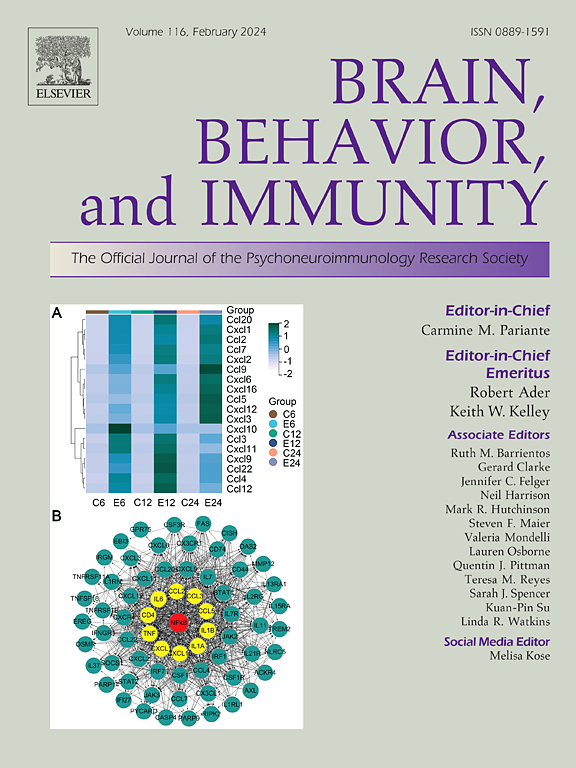抗抑郁治疗后抑郁症患者血浆犬尿氨酸途径代谢物水平升高
IF 8.8
2区 医学
Q1 IMMUNOLOGY
引用次数: 0
摘要
犬尿氨酸(KYN)途径有助于调节与重度抑郁症(MDD)有关的生理系统。我们发现,抑郁症患者血浆中KYN、犬尿酸(KA)、黄尿酸(XA)、3-羟基苯甲酸(3-HAA)和吡啶酸(PA)的水平较低。然而,抗抑郁药物(AD)治疗后这些水平是否恢复以及这种恢复是否与临床改善有关仍不清楚。本文研究了METADAP队列中173名抑郁症患者和214名健康对照者的空腹血浆色氨酸(TRP)和这些代谢物水平,以及KYN/TRP比率。在基线和开始AD治疗后3个月和6个月获得测量值。采用线性混合效应模型分析治疗后代谢物的变化及其与17项汉密尔顿抑郁评定量表(HDRS)评分变化的关系。AD治疗后血浆代谢物水平升高,其中KA (PFDR = 0.00014)、3-HAA (PFDR = 0.034)和PA (PFDR = 0.0097)显著升高。KYN/TRP比率和KA未能恢复到健康对照水平。KYN/TRP比值(coef = -1.08, 95% CI[-1.92—0.23],PFDR = 0.045)和KYN水平(coef = -2.37, 95% CI[-3.83—0.91],PFDR = 0.0011)的增加与HDRS评分降低显著相关,表明抑郁症状改善。总之,我们观察到抑郁症患者在AD治疗6个月后血浆KYN通路代谢物水平升高,对一些患者来说,这与临床改善显著相关。我们的研究结果表明,这些代谢物的增加可能与治疗抑郁症有关。本文章由计算机程序翻译,如有差异,请以英文原文为准。
Plasma kynurenine pathway metabolite levels increase in depressed patients after antidepressant treatment
The kynurenine (KYN) pathway helps regulate physiological systems implicated in major depressive disorder (MDD). We showed that plasma levels of KYN, kynurenic acid (KA), xanthurenic acid (XA), 3-hydroxyanthranilic acid (3-HAA), and picolinic acid (PA) are lower in depressed individuals. However, whether these levels are restored following treatment with antidepressant drugs (AD) and if this restoration is associated with clinical improvement remains unclear. Fasting plasma levels of tryptophan (TRP) and these metabolites, as well as the KYN/TRP ratio, were investigated in 173 depressed patients of the METADAP cohort and 214 healthy controls of VARIETE. Measures were obtained at baseline and 3 and 6 months after beginning AD treatment. Post-treatment changes in metabolites and their associations with changes in the 17-item Hamilton Depression Rating Scale (HDRS) score were analyzed using linear mixed-effects models. Plasma metabolite levels increased following AD treatment, with significant increases in KA (PFDR = 0.00014), 3-HAA (PFDR = 0.034), and PA (PFDR = 0.0097). The KYN/TRP ratio and KA failed to return to healthy control levels. Increases in the KYN/TRP ratio (coef = -1.08, 95 %CI [-1.92–-0.23], PFDR = 0.045) and KYN levels (coef = -2.37, 95 %CI [-3.83–-0.91], PFDR = 0.0011) were significantly associated with HDRS score reductions, indicating depressive symptom improvement. Altogether, we observed increases in plasma KYN pathway metabolite levels in depressed patients following 6 months of AD treatment that, for some, was significantly associated with clinical improvement. Our findings suggest increases in these metabolites may be relevant to treating depression.
求助全文
通过发布文献求助,成功后即可免费获取论文全文。
去求助
来源期刊
CiteScore
29.60
自引率
2.00%
发文量
290
审稿时长
28 days
期刊介绍:
Established in 1987, Brain, Behavior, and Immunity proudly serves as the official journal of the Psychoneuroimmunology Research Society (PNIRS). This pioneering journal is dedicated to publishing peer-reviewed basic, experimental, and clinical studies that explore the intricate interactions among behavioral, neural, endocrine, and immune systems in both humans and animals.
As an international and interdisciplinary platform, Brain, Behavior, and Immunity focuses on original research spanning neuroscience, immunology, integrative physiology, behavioral biology, psychiatry, psychology, and clinical medicine. The journal is inclusive of research conducted at various levels, including molecular, cellular, social, and whole organism perspectives. With a commitment to efficiency, the journal facilitates online submission and review, ensuring timely publication of experimental results. Manuscripts typically undergo peer review and are returned to authors within 30 days of submission. It's worth noting that Brain, Behavior, and Immunity, published eight times a year, does not impose submission fees or page charges, fostering an open and accessible platform for scientific discourse.

 求助内容:
求助内容: 应助结果提醒方式:
应助结果提醒方式:


